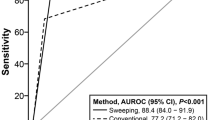Abstract
Helicobacter pylori in the stomach is an etiological factor of gastritis and peptic ulcer. It is now considered that gastric cancer can be, at least in some cases, a late complication ofH. pylori infection. In 123 consecutive endoscopic antral biopsies obtained from patients with the OkamotsoHospital, the specimens were subjected to the rapid urease test (RUT), histology (H&E stain), and culture, for the identification ofH. pylori. The results of these methods were compared semi-quantitatively in order to evaluate these detection methods for identifyingH. pylori. The results of these methods were found to agree well, with the Spearman's rank correlation coefficient between RUT and culture being 0.90 (P<0.01) and that between histology and culture being 0.80 (P<0.01). RUT is considered to be a very simple, sensitive, and highly specific test which enables the endoscopist to diagnoseH. pylori infection.
Similar content being viewed by others
References
Warren JR. Unidentified curved bacilli on gastric epithelium in active chronic gastritis. Lancet 1983;I:1273.
Haruma K, Okamoto S, Sumi K, et al.Helicobacter pylori infection and gastroduodenal disease: A comparison of endoscopic findings, histology, and urease test data. Hiroshima J Med Sci 1992;41:65–70.
Wyatt JI, Rathbone BJ, Dixon MF, et al.Campylobacter pyloridis and acid-induced gastric metaplasia in the pathogenesis of duodenitis. J Clin Pathol 1987;40:841–848.
Parsonnet J, Friedman GD, Vandersteen DP, et al.Helicobacter pylori infection and the risk of gastric carcinoma. N Engl J Med 1991;325:1127–1131.
Rauws WAJ, Tytgat GNJ. Cure of duodenal ulcer associated with eradication ofHelicobacter pylori. Lancet 1990;335:1233–1235.
Tucci A, Corinaldesi R, Stanghellini V, et al. One-day therapy for treatment ofHelicobacter pylori infection, Dis Dis Sci 1993;38:1670–1673.
Wagner S, Freise J, Bär W, et al. Epidermiologie und therapie derCampylobacter-pylori infektion. Dtsch Med Wochenschr 1989;114:407–413.
Rathbone BJ, Wyatt JI, Worsley BW, et al. Systemic and local antibody responses to gastricCampylobacter pyloridis in nonulcer dyspepsia. Gut 1986;27:642–647.
Kaldor J, Tee W, McCarthy P, et al. Immune response toCampylobacter pyloridis in patients with peptic ulceration. Lancet 1985;I:921.
Goodwin CS, Blincow E, Peterson G, et al. Enzyme-linked immunosorbent assay forCampylobacter pyloridis: Correlation with presence ofC. pyloridis in the gastric mucosa. J Infect Dis 1987;155:488–494.
Graham DY, Klein PD, Evans DJ, et al.Campylobacter pylori detected non-invasively by the13C-urea breath test. Lancet 1987;I:1174–1177.
Bell GD, Weil J, Harrison G, Morden A, et al.14C-urea breath analysis, a non-invasive test forCampylobacter pylori in the stomach. Lancet 1987;1:1367–1368.
Kohli Y, Kato T, Iwaki M, et al. The distribution ofHelicobacter pylori in human gastric mucosa in vivo. Dig Endosc 1991;3:457–460.
Ishii E, Kishi T, Inoue H, et al. Isolation ofCampylobacter pyloridis from gastric mucosa of patients with gastric complaints and susceptibility of the isolates on antibiotics. J Jpn Assoc Infect Dis 1987;61:668–675.
Mendoza ML, Rabadan PM, Carrion I, et al.Helicobacter pylori infection, rapid diagnosis with brush cytology. Acta Cytologica 1993;37:181–185.
Clayton CL, Kleanthous H, Coates PJ, et al. Sensitive detection ofHelicobacter pylori by using polymerase chain reaction. J Clin Microbiol 1992;30:192–200.
McNulty CAM, Wise R. Rapid diagnosis ofCampylobacter-associated gastritis. Lancet 1985;I:1443–1444.
Morris A, Mclntyre D, Rose T, et al. Rapid diagnosis ofCampylobacter pyloridis infection. Lancet 1986;I:149.
Marshall BJ, Warren JR, Francis GJ, et al. Rapid urease test in the management ofCampylobacter pyloridis-associated gastritis. Am J Gastroenterol 1987;82:200–210.
Lamouliatte H, Megraud F, DeMascarel A, et al.Campylobacter pyloridis and epigastric pain: Endoscopie, histological, and bacterological correlations. Gastroenterol Clin Biol 1987;11:212–216.
Madan E, Kemp J, Westblom TU, et al. Evaluation of staining methods for identifyingCampylobacter pylori. Am J Clin Pathol 1988;90:450–453.
Walters LL, Budin RE, Pauli G. Acridine orange to identifyCampylobacter pyloridis in formalin-fixed, paraffin-embedded gastric biopsies. Lancet 1986;I:42.
Niedobitek F, Grosse G, Hammer M, et al. Gastritis and bacterial colonization of the gastric mucosa in adolescents. Am J Gastroenterol 1989;84:239–244.
Megrand F. Comparison of different tests forCampylobacter pylori. Scand J Gastroenterol 1988;23[Suppl 142]:64–68.
Author information
Authors and Affiliations
Rights and permissions
About this article
Cite this article
Kawanishi, M., Fukuda, S., Kawaguchi, H. et al. Significance of rapid urease test for identification ofHelicobacter pylori in comparison with histological and culture studies. J Gastroenterol 30, 16–20 (1995). https://doi.org/10.1007/BF01211369
Received:
Accepted:
Issue Date:
DOI: https://doi.org/10.1007/BF01211369




